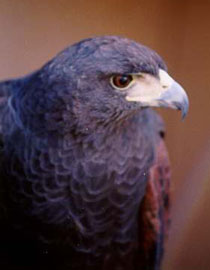Pigeons in the Park
Air Date: Week of August 8, 2003
New York City's Bryant Park is trying a novel way to rid the area of pigeons -- call in the hawk patrols. Host Steve Curwood talks with raptor specialist Tom Cullen about what he and his birds are doing in the park.
Transcript
CURWOOD: Many New Yorkers are resigned to the fact that parks and pigeons are an eternal partnership. But Bryant Park in midtown Manhattan is trying out a novel plan to get rid of the winged loiterers and their droppings. Park administrators have called in a team of hawks to scare off the pigeons. Tom Cullen is the raptor specialist who is running the program. Tom, how do you and the hawks on your crew go about getting rid of the pigeons in the park?
 Harris’ Hawk (Photo: Southwest Wildlife) Harris’ Hawk (Photo: Southwest Wildlife) |
CULLEN: Basically the Harris’ hawk is a bird that's specifically designed to catch ground quarry, things like rodents and squirrels, rabbits. The pigeons don't realize that the particular hawk that I'm using is not well adapted to catch them, and what we're relying on is the instinctive behavior of pigeons to avoid hawks. We're not actually hunting the pigeons, per se, in the park. What we're doing is we're using that natural fear to build the stress level up, so that the pigeons basically avoid the area because there's a predator on the prowl.
CURWOOD: How do you control your hawks? CULLEN: Basically, we use the ancient methods of falconry to train the birds. Basically, they're taught to come to us for food. And so we control them that way. My birds are trained to follow me like a dog would, except, of course, they follow me from treetop to treetop. CURWOOD: So what sort of controls do you use, your body, your voice? How do you do this? CULLEN: A little bit of both. I can get their attention by yelling at them or whistling to them so that they turn their head. But because they're so visually orientated, what I have to do to actually bring them down is show them something, either a lure that's dragged along the ground or actually just a small piece of meat, and place it in my gloved hand and they come down to that. CURWOOD: Maybe you could let us hear what it sounds like when you call one of your hawks back to you. CULLEN: Oh just kind of a [WHISTLES] and you can hear her bells in the background here. She wears bells so that I can locate her if she were to go down into cover. So I kind of hear a jingle-jingle as she follows me along. CURWOOD: What's her name? CULLEN: The one I have on my fist at the moment is called Starbuck. CURWOOD: So she does caffeine in the morning, I take it. CULLEN: Well, they're kind of a dark, chocolatey-brown bird with a little bit of, kind of, reddish shoulders. And I named one of them Mocha, so then I ended up naming another Java. So Starbuck just kind of seemed to fall in line. CURWOOD: You're a man who enjoys a good cup of coffee. CULLEN: That's right. CURWOOD: You know, if these pigeons get moved out of Bryant Park, and then may be they get moved out of Times Square, and maybe they get moved out of… CULLEN: Well they can always go to Jersey. That would suit me. [laughter] As long as they're out of Bryant Park, I'm happy. Again, if I leave, it's more than likely they're going to come back in again. So it is a kind of maintenance program that we're doing here. CURWOOD: Tom Cullen is a raptor specialist. He talked to us from Bryant Park in New York. Hey, are you going to fly your birds now? CULLEN: Yes. [BELLS RINGING] There we go. CURWOOD: Thanks a lot, Tom. CULLEN: Okay. Links
|





